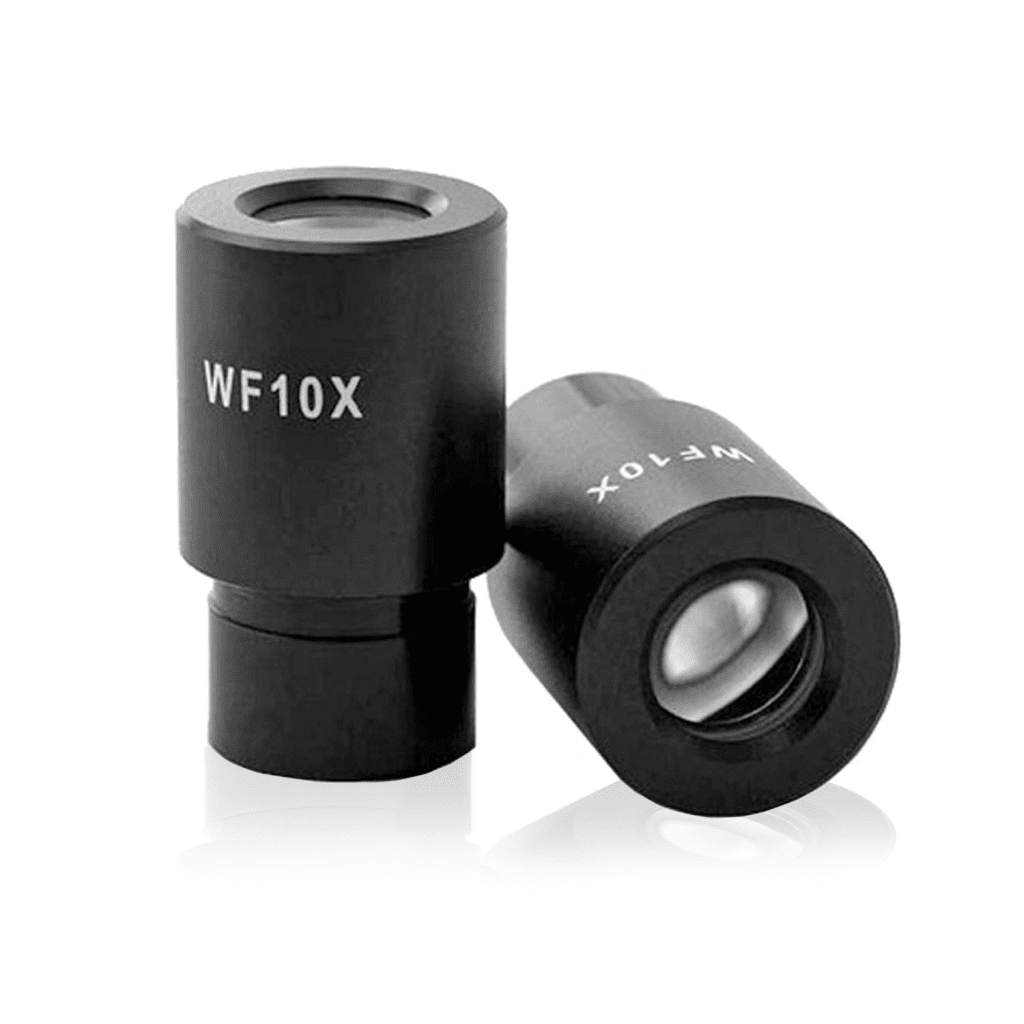TABLE OF CONTENTS:
You might wonder what is the function of the eyepiece on a microscope, and its simply part of the optics that magnify the object you are trying to view. The two main parts of the optical system in a microscope are the eyepiece and objective. In this article we review everything about microscope eyepieces.
What is the eyepiece of a microscope?
Microscope eyepieces are the lenses that you look through, near where you place your eye. The optical tube is what part of the microscope that holds the eyepiece. A compound microscope has one or more eyepieces that can be changed or swapped to other eyepieces, if they are compatible with the same tube diameter. There may be different names of eyepieces like a Huygenian eyepiece or Ramsden eyepiece or Kellner eyepiece, but don’t let these names scare you! These are just different lens assemblies named after the scientists who came up with the designs.
Does light enter the eyepiece first in the microscope?
No, the light comes up through the specimen and objective lenses first, and then its passes through the eyepiece system last and then that light travels straight to your eye. Actually the eyepiece is the last part in the path of light that then enters your eye, so you can view your sample.
What does the eyepiece do on a microscope?
The eyepiece is half of the optical system that lets you see the object with a magnified view. The other part is the objective. The combination of the eyepiece and the objective provides you with the total magnification.
What does the ocular lens do on a microscope?
The ocular lens on a microscope is just another way to refer to the eyepiece. Ocular refers to your eye, so its just another way to explain the lens system where you place your eye to view the specimen. In microscopy, ocular lenses are typically referred to as eyepieces.
What does WF mean on an eyepiece?
WF on a microscope eyepiece means wide field. The field of view or how much area you can see through the eyepiece is extra wide. The optics are designed to increase the view by having better optical designs, more lenses, or larger diameter lenses.
What is the magnification of the eyepiece?
So how much does the eyepiece of a microscope magnify? On each eyepiece, there is a number followed by an X. For example, 10X is the power of the eyepiece. Now you know what is the eyepiece power of your microscope. It’s not the total power of the microscope, for that you need to multiply the eyepiece power by the objective power. Most eyepieces are 10X or 16X and that provides plenty of power for optical microscopes. How many eyepieces are on your microscope? If there are two, that’s called a binocular microscope or binocular head microscope and the eyepieces should have the same matching magnification. How many eyepieces does a monocular microscope have? Just one.
How to find eyepiece field number (FN)?
What is the field number in microscope? The field number (FN) is the diameter of the range that can be seen through the eyepiece. The final area depends on the objective lenses as well, but the field number lets you know the capability of the eyepiece itself. You can find this number written on the side of the eyepiece usually followed by mm for millimeters.
What is the field of view on a microscope?
If you want to know the total field of view on a microscope, you first need to find the field number of the eyepiece, written on the side of the eyepiece in mm or millimeters.
Take that field number and divide it by the magnification of the objective lens. That gives you the field of view in millimeters, so when you look at a sample through the optical system of the microscope, you can see at most that many millimeters across in size. So if your object is 2 mm and your total field of view is only 1 mm, you will not be able to see your entire object at once.
What is the number of mm mean eyepiece?
The number in millimeters or mm on the eyepiece lens means the field number of the compound microscope. How to find the field number on a microscope? Look at the number on the side that says for example, 18 mm. That is the field number of a microscope eyepiece. The higher the number, the wider the field of view for that eyepiece. If you need a wider field of view, you can switch it out for another eyepiece that is wider so has a larger field number. The field number is not the same as the focal length of the eyepiece, field number refers to size of viewable area, and focal length is another way to calculate the power it can magnify.
What is eye relief of an eyepiece?
Eye relief is the ideal distance from the outside surface of the eyepiece to your eye, so that your image is maximized in size. Microscopes with long eye relief tend to be more comfortable, as you don’t have to place your eye right up to the eyepiece, you can sit back a bit more. The optics involved in achieving longer eye relief are more complex usually so the cost is more expensive. If you are a glasses wearer and you don’t want to remove your glasses when viewing through the microscope, it’s much more helpful to have a microscope eyepiece with long eye relief.
How do you clean microscope eyepiece lens?
The best way to clean microscope eyepiece is to use a slightly damp microfiber cloth. Be sure to clean the outer surfaces and inner surfaces to remove any dust. Do not use any abrasives, alcohols, ammonia or other harsh or unknown chemicals.
How to adjust microscope eyepieces?
The eyepieces may or may not be adjustable depending on your microscope, where you may have a knob called a diopter adjustment. This is usually found on binocular microscopes, where are there are two tubes and two eyepieces. You can then adjust the focus from the left eyepiece to the right eyepiece using the diopter adjustment. This is very similar to how many binoculars work as well.
 OPTICS UNIVERSITY
OPTICS UNIVERSITY


Why can’t I use the two stronger object lenses on my microscope? It’s a bosh loam older model. I can never focus anything through the two stronger ones.
Unfortunately, sometimes companies sell microscopes where the higher objectives don’t work, or are so hard to focus they don’t work. However, remember that you need to refocus everytime you switch objectives, go slow and be patient, you may just be ‘skipping over’ the focus.
I have a 1923 Bausch, and the two high power lenses can only focus through a drop of optical oil (they will say “oil” on the side of the obj.)
Higher magnification, usually nearing 1000×, only works through a fluid. This fluid bridges the gap between the objective and the slide cover so that refraction does not drastically affect the optical transmission. Also, at such a high magnification, you are focusing on such a small area and the objective is so long (high aspect ratio) that there is very little light that would come through. The immersion oil helps illuminate the subject by bringing light from 360° around the fluid bridge.
I cоuld not refraіn from commenting. Very well written!